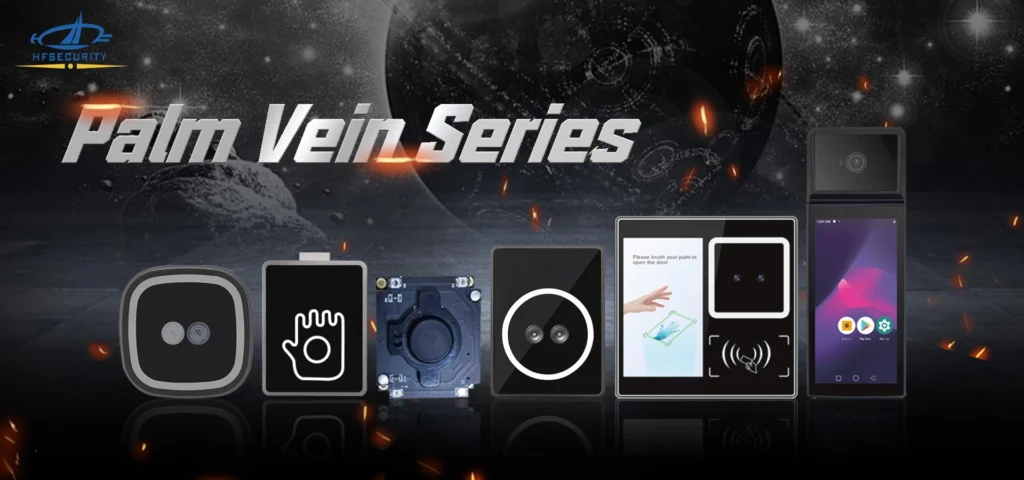手のひら静脈デバイスソリューションサプライヤー
手のひら静脈デバイスは、手のひら静脈認識システムまたは手のひら静脈スキャナとも呼ばれ、個人の手のひらの静脈のユニークなパターンを利用して識別と認証を行います。各個人に固有で、長期間にわたって比較的安定しているこれらの静脈パターンは、画像取得プロセスで近赤外線を使用してキャプチャされます。血液中のヘモグロビンがこの光を吸収し、キャプチャされた画像では静脈が暗い線として表示されます。

生体認証手のひら静脈メーカー HFSECURITY
HFSecurity は、生体認証手のひら静脈製品の大手メーカーです。当社の製品は、セキュリティ、身分証明、勤怠管理など、さまざまな用途に使用されています。HFSecurity の製品は、当社独自の手のひら静脈認証技術 (PVAT) に基づいています。これは、現在入手可能な生体認証技術の中で最も正確で信頼性の高い技術の 1 つです。PVAT は、個人の手のひら静脈の独自のパターンを使用して、認証に使用できるテンプレートを作成します。HFSecurity の製品は安全性と拡張性に優れており、既存のシステムに簡単に統合できます。さらに、当社の製品は業界をリードするカスタマー サポートによって支えられています。当社の製品の詳細と、当社がお客様の施設のセキュリティ確保にどのように貢献できるかについては、今すぐお問い合わせください。
手のひら静脈デバイスサプライヤー HFSECURITY
生体認証手のひら静脈について知っておくべきこと
生体認証による手のひら静脈認識技術は、人の手のひらにある静脈の独特なパターンを利用して、その人を識別します。このタイプの認証は非常に正確であると考えられており、セキュリティの高い状況でよく使用されます。さらに、生体認証による手のひら静脈認識は、なりすましが難しく、汚れや汗などの要因の影響を受けません。手のひら静脈認識技術は、アクセス制御、勤怠管理、本人確認など、さまざまな目的に使用できます。ユーザーを認証する安全な方法をお探しの場合は、生体認証による手のひら静脈認識が最適なソリューションです。

生体認証手のひら静脈技術の目的は、安全かつ便利な方法で個人を認証することです。この技術では、人の手のひらの静脈のユニークなパターンを使用して、検証に使用できるテンプレートを作成します。このテンプレートはデータベースに保存され、将来のスキャンと比較されて個人の身元が確認されます。生体認証手のひら静脈技術は、アクセス制御、勤怠管理、キャッシュレス販売など、さまざまな用途で使用されています。この技術は、正確性と利便性が最も重要となる、セキュリティの高い環境でよく使用されます。
赤外線ライトが手のひらの静脈を照らします
カメラは静脈の画像を撮影する
プロセッサは画像を分析し、静脈パターンに関する情報を抽出します。
この情報はその後の分析のために画面に表示されます。
指紋や虹彩スキャンなどの外部特徴に依存する他の生体認証技術とは異なり、手のひら静脈は体内部分、つまり手の静脈に依存します。これらの静脈は各個人に固有であり、時間が経っても一定であるため、識別の理想的な基盤となります。この技術を使用するには、特別なスキャナーに手を置くだけです。スキャナーは静脈パターンをマッピングし、それを使用して身元を確認します。
手のひら静脈を認証に用いると、生きている手のひらにのみ存在する静脈の画像特徴量が得られます。このシステムでは、生きている手のひらには静脈の画像特徴量がないため、静脈を識別できず、偽造もできません。
手のひら静脈認証では、手のひら表面の画像特徴ではなく、手のひら内部の静脈画像特徴を取得するため、手のひら表面の損傷、摩耗、乾燥、濡れなどによる認証の障害がありません。
手のひら静脈を認証に利用する場合、手のひら静脈画像を取得する際に手のひらをデバイスに接触させる必要がなく、軽く離すだけで認証が行われます。この方法は、デバイスに手が接触することによる不衛生な問題や、指表面の特徴がコピーされる可能性によるセキュリティ上の問題がありません。
手のひら静脈認証システムはセキュリティレベルが高く、特にセキュリティ要件が高い場所での使用に適しています。
まず第一に、スキャナが既存のコンピュータシステムと互換性があることを確認する必要があります。
オンライン、店舗、またはメーカーから見つけることができます。オンラインで購入する場合は、信頼できる販売者から購入するようにしてください。
店舗で購入する場合は、スキャナーを実際に見て、それについて質問することができます。
最後に、メーカーから購入した場合、高品質の製品を確実に入手できます。
さらに、USB ベースのスキャナと PS/2 ベースのスキャナのどちらが必要かを決める必要があります。手のひら静脈スキャナには通常、コンピュータなしで使用できるスタンドアロン デバイスと、動作するためにコンピュータに接続する必要がある「プラグ アンド プレイ」デバイスの 2 つの異なるフォーム ファクタがあります。
一度に 1 人のみをスキャンする必要がある場合は、シングルユーザー デバイスで十分ですが、複数の人をスキャンする必要がある場合は、マルチユーザー デバイスを購入する必要があります。
手のひら静脈スキャナの精度は通常97%から99%の間ですが、より高い精度が必要な場合は、より高価なモデルを購入する必要があるかもしれません。






